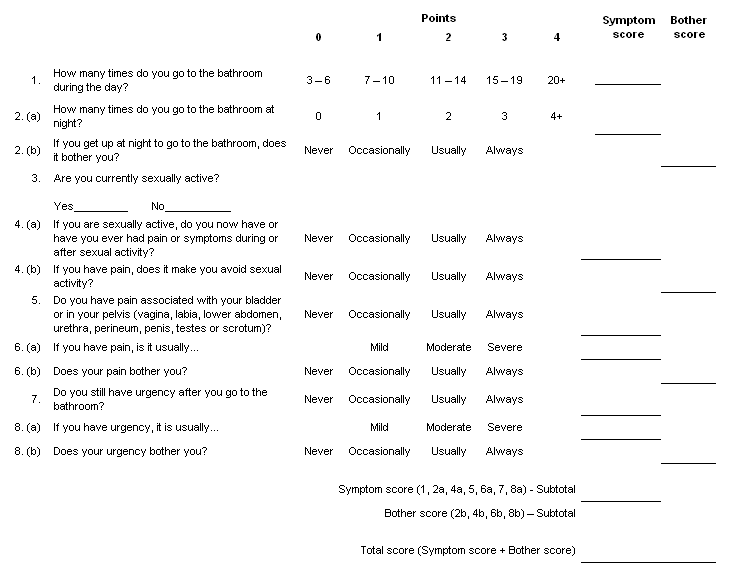Monitoring
Patients should be followed up at 6 weeks with a Pelvic Pain and Urgency/Frequency (PUF) Questionnaire score to monitor improvement and symptom response to chosen therapies (PUF score is preferred to be <9).[Figure caption and citation for the preceding image starts]: Pelvic Pain and Urgency/Frequency (PUF) QuestionnaireInterstitial Cystitis Foundation [Citation ends]. If the patient is stable, a 3- to 4-month interval follow-up during the first year is reasonable. Patients who show only modest improvement will need to be followed up every 6 weeks while their drugs are adjusted or changed. Once stable, they may follow the above 3- to 4-month interval for at least the first year. Patients should be asked about adverse effects, particularly any anti-cholinergic effects (e.g., dry mouth, constipation, mydriasis, and urinary retention). Pain symptoms should be measured subjectively or objectively with a visual analogue scale.
If the patient is stable, a 3- to 4-month interval follow-up during the first year is reasonable. Patients who show only modest improvement will need to be followed up every 6 weeks while their drugs are adjusted or changed. Once stable, they may follow the above 3- to 4-month interval for at least the first year. Patients should be asked about adverse effects, particularly any anti-cholinergic effects (e.g., dry mouth, constipation, mydriasis, and urinary retention). Pain symptoms should be measured subjectively or objectively with a visual analogue scale.
Additional testing at the time of an exacerbation is very useful and can ensure that no other treatable comorbidity such as a urinary tract infection, an episode of irritable bowel syndrome, or endometriosis is responsible for symptoms of pelvic pain or voiding dysfunction.
Referral to a pain clinic may be recommended in some instances. For patients who have an established psychiatric history, working with a psychiatrist can benefit the physician and the patient.
Neuromodulation requires at least yearly checks for device function and battery life. Special circumstances require device explant (pregnancy, need for non-head MRI imaging).
Use of this content is subject to our disclaimer